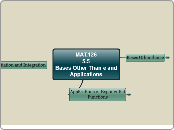MAT.126
5.5
Bases Other Than e and Applications
Bases Other than e
Definition of Exponential Function to Base a
Laws of Exponents
Definition of Logarithmic Function to Base a
Logarithmic Properties
Inverse Function Properties
Common Logarithmic Function
Applications of Exponential Functions
Compound Interest
Continuously Compounded Interest
Logisitic Growth
Differentiation and Integration
Derivatives for Bases Other Than e
Integration
A comparison of 4 rules for differentiation
